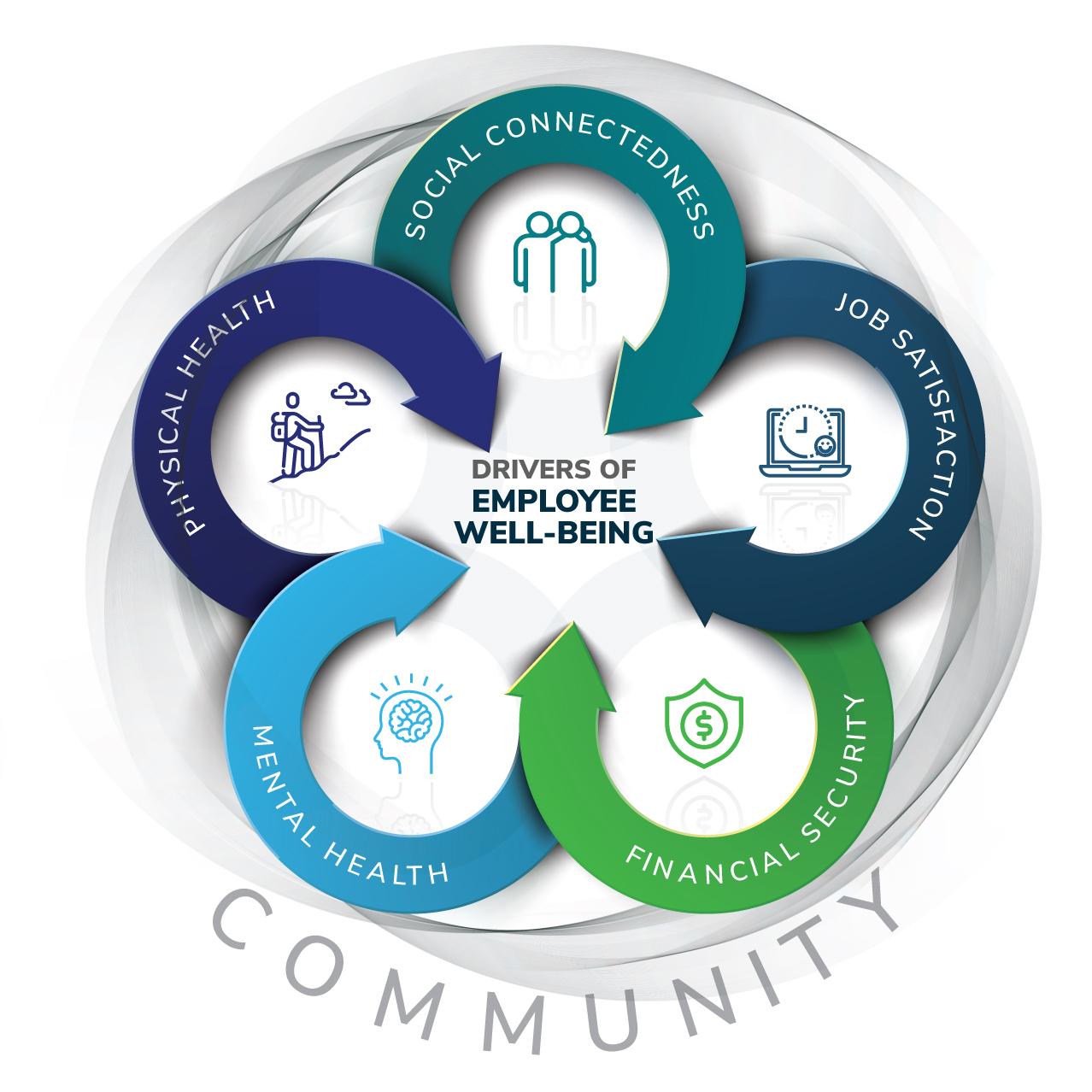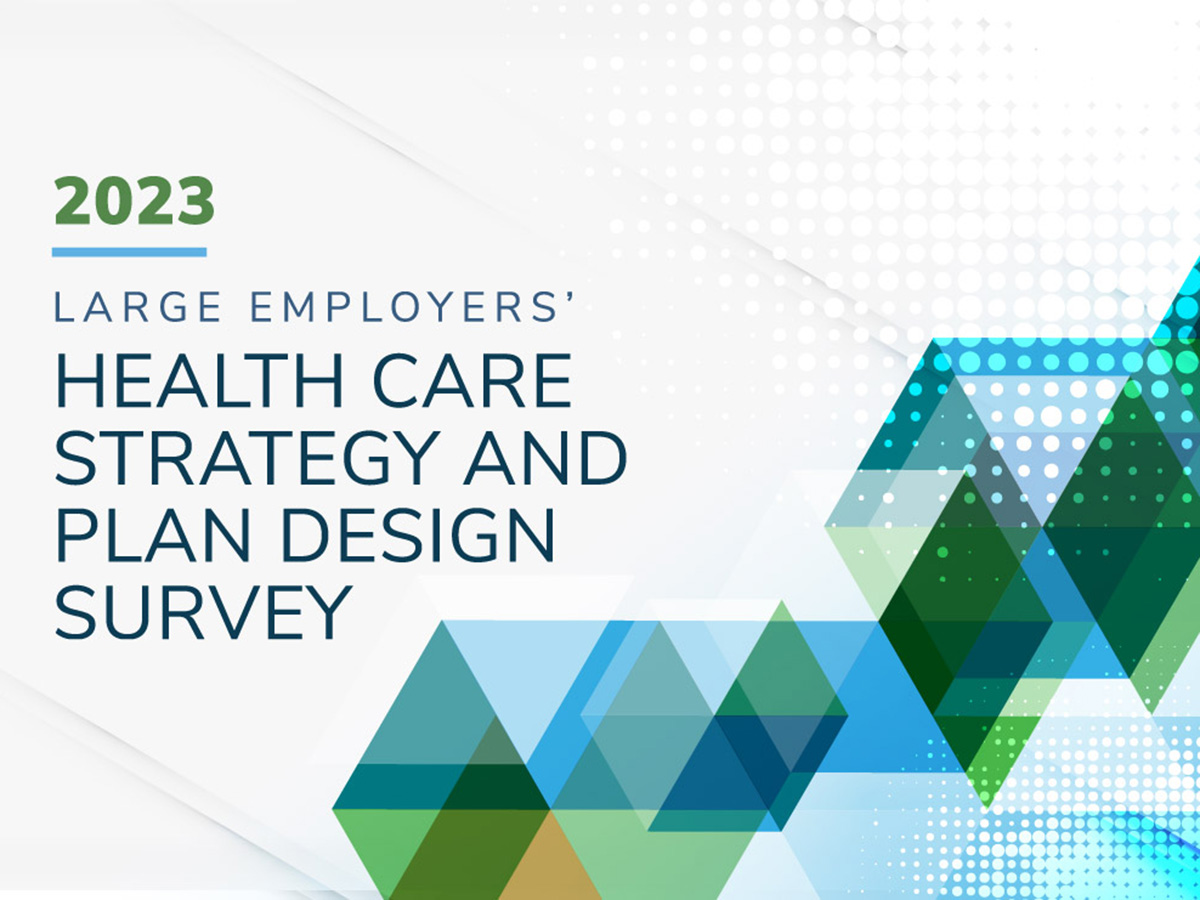September 23, 2022
Employers have fully embraced multidimensional well-being strategies as a growing body of evidence shows that supporting employees holistically has far greater impact than a singular focus on physical health. These broader well-being strategies are influenced by current events and global trends and are continuously evolving to meet employees’ changing needs and priorities, and to align with organizational culture and goals.
This resource lays out how employers are reimagining their strategies by providing a snapshot of current offerings across six dimensions of well-being: physical health, mental health, financial security, social connectedness, job satisfaction and community. The document also forecasts the future state of each dimension and serves as a companion piece to “The Future of Workforce Well-Being,” which outlines five macrotrends shaping the scope, focus and goals of employer well-being strategies overall.

Mental Health
Signaling employer understanding that employees view mental health as the most important aspect of well-being and that employees’ needs are broad, varied and sometimes urgent, mental health is now the primary dimension of employers’ well-being strategies.1 Employers are offering a range of programs and benefits focused on both prevention and treatment, which are proving important at a time when 44% of employers are seeing the impact of the pandemic on long-term mental health issues (e.g., depression, anxiety, substance use disorders), with an additional 44% anticipating future impact.2
In 2022, employers are offering the following programs to support mental health:
- Telephonic employee assistance programs (EAPs) (97%);
- Teletherapy (85%);
- Mindfulness programs (74%);
- Stress management programs (65%);
- Resiliency programs (63%);
- Sleep improvement programs (47%);
- Digital cognitive behavioral therapy (43%); and
- Happiness programs (40%).
Beyond these benefits and programs, 28% of employers are providing pediatric-focused mental health support in 2022, likely due to the “youth mental health crisis” highlighted prominently by the U.S Surgeon General.1 This focus will increase in the future, with 58% of employers considering implementing pediatric mental health support in 2023, illustrating the profound need for evidence-based care (and the outsized impact that children’s mental health has on parental mental health), and the emergence of new solutions.
In addition to many of the virtual programs noted above, some employers are offering on-site mental health or EAP support; among those with on-site (or near-site) clinics, 65% of employers are offering mental health services and 63% are offering on-site EAP in 2022.2
In tandem with the varied programs and services already in place, employers have initiatives underway to create psychologically healthy workplaces. Among these are manager and peer training to help recognize mental health issues and direct employees to appropriate services (offered by 74% and 40% of employers, respectively).2 Relatedly, in 2022, 37% of employers have mental health champions/allies in place , employees who serve as important conduits to mental health benefits and programs. These initiatives are vital to an employer’s strategy, especially since peers/colleagues and supervisors are well positioned to support employee mental and emotional health.3 Anti-stigma campaigns (70%) and flexible work schedules that encourage employees to seek care during work hours (48%) are other ways employers sought to promote open discourse and normalize mental health in 2022.2
Outlook
Mental health will continue to be a top priority among employers and employees, recognized as inextricably linked to other dimensions of well-being, including physical, financial and social health, as well as job satisfaction. Knowing that the mental health system has historically not served the needs of Black, Indigenous, and People of Color (BIPOC) and LGBTQ+ populations, employers will remain steadfast in their pursuit of mental health care that prioritizes inclusion. Greater attention will be focused on behavioral health issues still emerging from the shadows, including suicide, substance use disorders and eating disorders, with employers exploring how vendor partners both old and new can address these serious challenges in a timely and evidence-based fashion. Workplace conversations about mental health will become the norm, and feedback from employees garnered through employee resource groups (ERGs), pulse surveys and focus groups will influence the continuous evolution of mental health strategies.
Leaders from across the organization will consider how workplace culture and job design, such as greater flexibility, time away, autonomy and attention to work/life needs, manager training (with a focus on empathy and authenticity), practices to promote team cohesion and social support and communication, can prevent and address the root causes of issues like burnout and loneliness – problems that can’t be solved with mental health treatment alone. They’ll also tweak common workplace practices, such as happy hours, so that they are more inclusive of employees in recovery from substance use disorders, by deemphasizing alcohol in social gatherings. And on that note, employers will account for how different dimensions of well-being intersect and influence one another by infusing mental health into everything as they design initiatives, select vendor partners and require greater integration between solutions for better cross promotion. Finally, more attention will be paid to prevention and resiliency to help employees avoid and better withstand mental health challenges.
Related Resources
Physical Health
Supporting physical health has been foundational to almost all employer well-being strategies since the advent of wellness programs but is gaining renewed focus due to gaps in care driven by the pandemic. Fourteen percent of employers are already seeing higher chronic condition management needs as a result of the pandemic, with an additional 56% anticipating greater impact in the future.2
In 2022, employers are providing a variety of initiatives focused on the prevention and treatment of disease, all of which are expected to grow in 2023:1
- Chronic condition management (87%);
- Tobacco cessation (79%);
- Diabetes prevention and weight management (74%);
- Physical activity challenges (73%);
- Health assessments and biometric screenings (72% and 58% respectively);
- Maternity management (69%);
- Subsidies/discounts for off-site gym/virtual fitness memberships (68%);
- Lifestyle coaching (61%);
- Musculoskeletal programs (55%); and
- Family- forming and reproductive support (53%).
When it comes to motivating participation in physical health programs, most employers leverage well-being champions (63% in 2022) and financial incentives (68% in 2022).1 Among employers offering financial incentives to employees, 50% of the total incentive distribution is tied to health assessments and/or biometric screenings, 30% of the distribution is related to managing health challenges like weight or chronic conditions, 13% for mental health, and 7% for financial well-being.1
In addition to telehealth (which is offered almost universally by employers) and a suite of digital tools to support physical and mental health, on-site services and resources play an important role in employer well-being strategies. They provide convenient access to care and a supportive and healthy work environment. Many employers offer on-site gyms, treadmill or sit-to-stand desks and practices to promote the consumption of healthy food such as nutritional labeling, with some offering on-site health fairs, on-site fitness classes and on-site yoga and meditation in 2022.1 Additionally, among employers with on-site (or near-site) clinics, 79% offer well-being programs, including biometric screenings on-site (increasing to 85% in 2023), and 70% offer on-site chronic condition management.2
Outlook
Workplace design will play an even larger role in employers’ well-being strategies, far beyond the availability of on-site services. Organizations will focus on the features inside and outside of buildings that impact population health and well-being, such as ventilation and filtration (which can reduce disease transmission for COVID-19 and flu); employee access to water, natural light, stairs and other opportunities for movement throughout the day; biophilic design (which aims to integrate nature into building design); and noise control and thermal comfort, to name a few. Furthermore, employers will consider how they can apply the principles of a healthy work environment to home offices for those in hybrid or permanent work-from-home arrangements
An increasing focus on health assessments and biometric screenings in 2022 and 2023 will help employers determine whether current initiatives are meeting employee needs (and where they may have to create additional areas of support), as well as enable vendor partners to personalize recommendations. Newer models of care for chronic diseases, such as weight management programs that integrate pharmacotherapy with behavioral interventions, along with growing interest in food as medicine, will be important to employer efforts to promoting physical health.
Related Resources
Financial Security
Ninety-four percent of employers include financial wellness in their overall well-being strategy in 2022.1 While retirement savings is still a major part of employer financial well-being strategies, many organizations are offering and encouraging the use of programs and benefits to help employees with their day-to-day financial priorities and challenges. This broader view of employees’ financial lives that encompasses both the present and future is based on the understanding that stress about money impacts employee physical and mental health, productivity and performance.
In 2022, financial well-being initiatives include, but aren’t limited to, the following:1
- Tools and resources to support debt management and budgeting (79%);
- Financial health programs (75%);
- One-on-one financial planning with advisor/coach (72%);
- Resources to support key financial decisions like mortgages, wills and income protection (68%);
- Hardship loans (51%);
- Programs to enable emergency savings, such as savings accounts alongside the 401(k) and subsidies to support employees’ emergency savings (40% and 8%, respectively); and
- Student loan counseling and student loan repayment assistance (40% and 20%, respectively).
Some employers are also rolling out initiatives specific to employees who earn lower wages; in 2022, 9% of employers offer programs targeted to this population, such as low-cost loans or programs to raise credit scores, and 9% offer programs to enable early access to earned wages.1 The financial well-being of employees is also spilling over to the design of health benefits, with 37% of employers offering wage-based cost sharing (e.g., premiums, deductibles, out-of-pocket maximums), 61% designing pharmacy benefits to improve patient affordability of medications and 73% offering a variety of plan designs as a means of reducing health inequities.2
Outlook
In the face of economic uncertainty, employers will continue to offer a diverse portfolio of financial well-being benefits and programs that help employees address current concerns and prepare for the future, prioritizing offerings that focus on action (rather than education alone), which research shows is far more effective in reducing financial worries.4 Also a priority: addressing long-standing racial and gender disparities in financial well-being and promoting equity and inclusion. To do this, employers will rely on employee data and feedback (such as through ERGs, focus groups and surveys) in the development of financial initiatives, including how social determinants of health impact employees’ lives and their financial status. Financial well-being vendors will increasingly focus on equity and inclusion as a part of their services, understanding that financial needs may differ based on gender, race and ethnicity, sexual orientation, marital status, wage band, job classification, country or region, as well as intersectional identities. And financial well-being initiatives will account for the relationship between financial health and other dimensions of well-being, recognizing that they influence one another bidirectionally and must be acknowledged and responded to accordingly, such as through benefit or program integration.
Social Connectedness
A majority of employers (70%) include a focus on social connectedness as a part of their well-being strategy, showcasing widespread understanding that supportive positive relationships and social belonging are not only necessary for employee well-being, but important for business outcomes such as engagement.1 To promote connections among colleagues in 2022, 70% of employers hold in-person or virtual get-togethers. Most (79%) have ERGs in place and just under half (49%) offer employee support networks, both of which seek to promote familiarity and uncover common interests/similarities, which research says are crucial ingredients to friendship formation in the workplace and help create a sense of belonging and pride.1,5 Thirty-seven percent of employers provide programs to help employees overcome loneliness and isolation, knowing that even before the COVID-19 pandemic, loneliness was prevalent in modern life and detrimental to physical and mental health, as well as to individual and team work performance.1
Beyond promoting connections with colleagues, employers are putting policies and practices in place to enable employees to maintain relationships with loved ones and their broader community. Companies are providing flexible work policies, encouraging employees to use their time off, providing paid time away or flexibility for volunteerism, and sponsoring events that incorporate family and friends (for example, both LinkedIn and Google have held “Take Your Parents to Work Day”).6,7
Outlook
The COVID-19 pandemic drove home the fact that humans need to feel connected at work, home and to the broader community, and this lesson will stay with employers for years to come. Leaders across the organization, including benefits and well-being practitioners, will seek to foster connection, belonging and positive work relationships through intentional approaches to support high-quality social ties. Doing so will be critical to retaining employees, as relationships at work are one way employees can find meaning at work.8 Employers will assess the effect that hybrid work and permanent work from home has on employee connections and implement practices to forge or maintain collegial bonds; this may be through work policies or job design, or through team-based games, social events, volunteerism and physical health programs (e.g., walking challenges), as research shows that activities encouraging employees to collaborate to achieve a goal can also be particularly helpful in bringing colleagues closer.5 Additionally, companies will assess opportunities to promote friendship formation throughout the employee lifecycle, beginning with onboarding, and to deepen existing relationships, such as through leadership training.
Job Satisfaction
Although just 35% of employers included job satisfaction in their well-being strategy in 2021, that number grew to 52% in 2022.1 This increased focus indicates a growing acknowledgment of job satisfaction as a contributor to employee health and well-being; this is supported by research showing links between job satisfaction and employee turnover, customer satisfaction and loyalty, safety, productivity and health.9 Simultaneously, there’s an increasing sense of responsibility for job satisfaction among well-being leaders. Leave and work/life benefits are two prominent ways benefits leaders contribute to the dual goals of improved well-being and more positive feelings about work, as work/life harmony is one of the many factors influencing job satisfaction. In fact, large employers indicate that employee health and well-being is the top reason time away benefits are important to their company’s workforce strategy.10 Paid maternity leave (partial or fully paid salary through short-term disability) is nearly ubiquitous among surveyed employers (91% in 2022), and paid parental leave is not far behind in prevalence (90% in 2022).1 Fifty-three percent of employers offered caregiver leave in 2022, and 48% updated their PTO policies to offer additional days and/or greater flexibility in using days.1
In addition to offering leave and flexibility, well-being leaders are addressing other factors that research shows impact job satisfaction. Providing benefits and a safe and healthy work environment – which are rated by employees as ”extremely” or ”highly” important to job quality – are foundational to large employer well-being strategies and have never been more important as organizations seek to recruit and retain talent.11 Promoting social connectedness, another driver of job satisfaction, has also risen in importance as described above.
Encouraging positive manager behavior, characterized by a willingness to listen and show respect, care, support and appreciation, is an area of current focus. This is demonstrated by the 74% of employers who have implemented training to teach managers the signs of mental health distress and direct employees to appropriate resources; further, 33% plan to focus on burnout in 2023, an issue experts say must be tackled in part through empathetic leadership.2
Outlook
Fostering job satisfaction will increasingly be part of well-being leaders’ role as they consider how the initiatives that they’re responsible for can contribute to a positive employment experience. This increased focus will lead to partnerships across the organization in pursuit of shared goals, such as by integrating well-being into learning and development objectives. With employee demand for flexibility at an all-time high in a climate of economic uncertainty, employers will be mindful of how any changes to paid leave and flexible work arrangements will impact their ability to attract, and perhaps even more importantly, retain their workforce. Inclusivity will also become an important element of employers’ leaves strategies and diversity, equity and inclusion efforts. For example, more employers may expand the definition of family, rethink holidays and evaluate their leave benefits for consistency across different employee populations. Additionally, employers will consider how they can incorporate aspects of well-being beyond mental health into manager training and company goals; an additional area of focus will be organizational and individual purpose - and the connection between the two - as tapping into purpose has the potential to drive well-being and business outcomes.11 Finally, attention will be paid to the intersection between financial well-being and job satisfaction, with a particular emphasis on pay equity/fairness, which research shows is positively correlated with employee engagement and work/life satisfaction and negatively correlated with work stress and turnover intention.12
Related Resources
Community
In recent years, community has emerged as an important dimension of a well-being strategy, with employers focusing on both community involvement (i.e., encouraging volunteerism and engagement in local organizations) and the attributes of the communities in which employees live, work and play (i.e., addressing social determinants of health). In 2022, 67% of employers include community involvement in their well-being strategy.1 Benefits of doing so include fostering social connections, enhancing meaning and purpose, promoting an active lifestyle (depending on the type of volunteerism) and contributing to job satisfaction. The majority of employers offer charitable match giving programs (79%), collection drives (76%), team-building volunteer programs (71%), time off to volunteer (65%), skills-based volunteering/mentoring (41%), and employee well-being programs or use of employer facilities to members of the community (e.g., screening programs, 5K races, use of gyms or fields) (30%), all of which are expected to increase in 2023.1
Companies have also expanded the scope of their well-being strategies to address the social needs of employees -- individual-level solutions that seek to mediate the effects of community conditions negatively affecting employee health. They’re doing so because behavior change programs and health benefits may prove ineffective if social determinants, which influence 40% of our health status, aren’t also addressed.13 In 2022, most employers have programs and benefits in place to address two social determinants: health care (61%) and finances/income (56%).2 Although a bit lower in prevalence, employers are also addressing childcare (47%), racism (44%), transportation (28%), food access and insecurity (9%) and housing (9%), with expected increases in 2023.2
Outlook
To improve employee well-being, more employers will look outside their own walls and consider community as a lever for health. They will enhance community involvement for employees and work to integrate these efforts into their well-being strategies, such as by providing employees with opportunities or time off to volunteer.
Many employers will seek to more deeply understand the social needs of employees and their families by using data related to social determinants of health and employee input and feedback. With this information on hand, they will develop new solutions or alter existing ones in conjunction with vendor partners to address these needs. Some well-being leaders will take a step toward promoting changes in local communities that can improve population health and safety, such as putting in new sidewalks, playgrounds or recreational facilities. This will happen through the strategic alignment of corporate social responsibility, diversity and inclusion and internal benefits and well-being, which have shared interests and goals, including strengthening company brand and reputation, improving employee retention and satisfaction and advancing inclusion, to name a few. Addressing unmet community needs may also lead to partnerships with entities such as public health departments, in recognition that healthy communities are essential to healthy businesses.
Related Resources
More Topics
Articles & Guides- 1 | Business Group on Health and Fidelity Investments. 13th Annual Employer-Sponsored Health and Well-being Survey. https://www.businessgrouphealth.org/resources/13th-annual-health-and-well-being-survey. Accessed August 31, 2022.
- 2 | Business Group on Health. 2023 Large Employers’ Health Care Strategy and Plan Design Survey. https://www.businessgrouphealth.org/resources/2023-large-employers-health-care-strategy-survey-intro. Accessed August 3, 2022.
- 3 | Business Group on Health, ROC Group and Kantar. Impact & Influence: 2021 Study of Health and Well-being Communication. https://www.businessgrouphealth.org/resources/impact-influence-2021-study-of-health-and-well-being-communication. Accessed December 8, 2021.
- 4 | Leana C. The cost of financial precarity. Stanford Social Innovation Review; Spring 2019. https://ssir.org/articles/entry/the_cost_of_financial_precarity. Accessed December 8, 2021.
- 5 | Friedman R. The best place to work: The art and science of creating an extraordinary workplace. Perigee. 2015.
- 6 | Block L. Work rules! New York, New York: Hachette Book Group. 2015.
- 7 | LinkedIn. Bring in your parents day: Helping parents understand what you do. https://blog.linkedin.com/2017/november/10/bring-in-your-parents-day-helping-parents-understand-what-you-d. Accessed December 8, 2021.
- 8 | Rosales RM. Energizing social interactions at work: An exploration of relationships that generate employee and organizational thriving. Open Journal of Social Sciences. 2016.; https://www.scirp.org/journal/PaperInformation.aspx?PaperID=70707. Accessed December 8, 2021.
- 9 | Business Group on Health. Job satisfaction: The secret agent in well-being. https://www.businessgrouphealth.org/resources/job-satisfaction-the-secret-agent-in-well-being. Accessed December 9, 2021.
- 10 | Business Group on Health. 2020 large employers' leave strategy and transformation survey. 2021. https://www.businessgrouphealth.org/en/resources/2020-large-employers-leave-strategy-and-transformation-survey. Accessed December 14, 2021.
- 11 | Lumina Foundation, the Bill & Melinda Gates Foundation, Gallup and Omidyar Network. How COVID-19 affected the quality of work. https://www.luminafoundation.org/resource/2020-great-jobs-survey/. Accessed. December 8, 2021.
- 12 | NEF Consulting. Well-being at work: A review of the literature. http://neweconomics.org/2014/03/wellbeing-at-work/?lost=true&_sf_s=+publications+++well+being+at+work. 2014. Accessed December 9, 2021.
- 13 | McGinnis JM, Williams-Russo P, Knickman JR. The case for more active policy attention to health promotion. Health Aff. 2002; 21:78-93.
This content is for members only. Already a member?
Login
![]()

















